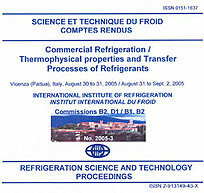
Document IIF
Modélisation de la consommation d'énergie des supermarchés.
Modelling supermarkets energy usage.
Auteurs : ARIAS J., LUNDQVIST P.
Résumé
Supermarkets and others food stores are intensive users of energy. In Sweden the supermarkets use about 3% of all available electricity in the country. The effective use of energy and the replacement of CFC and HCFC refrigerants are two factors that have influenced the refrigeration systems over the last few years, especially in supermarkets. New attractive refrigeration systems with indirect circuits and condenser heat recovery have been developed in order to minimize the refrigerant charge and to save energy. A computer model that predicts building heating and cooling loads, HVAC system performance and refrigeration system performance of a supermarket has been developed. The focus of the model is on energy use, environmental impact (TEWI) and life cycle cost (LCC) of the refrigeration system. Seven different system solutions for the refrigeration system in a supermarket are possible to simulate in the program. Measurements of different parameters such as outdoor and indoor temperatures, relative humidity, brine temperatures and compressor power have been carried out in seven supermarkets in Sweden to investigate the most important parameters that influence energy performance in supermarkets and to validate the model. A theoretical description of the model and results from the model and measurements are presented in this paper.
Documents disponibles
Format PDF
Pages : 2005-3
Disponible
Prix public
20 €
Prix membre*
Gratuit
* meilleur tarif applicable selon le type d'adhésion (voir le détail des avantages des adhésions individuelles et collectives)
Détails
- Titre original : Modelling supermarkets energy usage.
- Identifiant de la fiche : 2006-0816
- Langues : Anglais
- Source : Commercial Refrigeration. Thermophysical Properties and Transfer Processes of Refrigerants. Proceedings of the IIR International Conferences.
- Date d'édition : 30/08/2005
Liens
Voir d'autres communications du même compte rendu (140)
Voir le compte rendu de la conférence
Indexation
-
Field measurements in supermarkets.
- Auteurs : AXELL M., LINDBERG U.
- Date : 30/08/2005
- Langues : Anglais
- Source : Commercial Refrigeration. Thermophysical Properties and Transfer Processes of Refrigerants. Proceedings of the IIR International Conferences.
- Formats : PDF
Voir la fiche
-
Heat recovery and floating condensing in recent...
- Auteurs : ARIAS J., LUNDQVIST P.
- Date : 30/08/2005
- Langues : Anglais
- Source : Commercial Refrigeration. Thermophysical Properties and Transfer Processes of Refrigerants. Proceedings of the IIR International Conferences.
- Formats : PDF
Voir la fiche
-
An innovative heat pump desiccant dehumidifier ...
- Auteurs : LAZZARIN R. M., CASTELLOTTI F.
- Date : 30/08/2005
- Langues : Anglais
- Source : Commercial Refrigeration. Thermophysical Properties and Transfer Processes of Refrigerants. Proceedings of the IIR International Conferences.
- Formats : PDF
Voir la fiche
-
Application of best industry practices to the d...
- Auteurs : WESTPHALEN D., LITTLE A. D.
- Date : 16/07/2002
- Langues : Anglais
- Source : 2002 Purdue conferences. 2002 compressor engineering & refrigeration and air conditioning conferences at Purdue [CD-ROM].
Voir la fiche
-
Análisis del subenfriamiento integrado en los s...
- Auteurs : CATALÁN-GIL J., NEBOT-ANDRÉS L., SÁNCHEZ D., et al.
- Date : 19/06/2018
- Langues : Espagnol
- Source : CYTEF 2018. IX Congreso Ibérico y VII Congreso Iberoamericano de Ciencias y Técnicas del Frío, Valencia, España, 19-21 junio 2018.
- Formats : PDF
Voir la fiche
